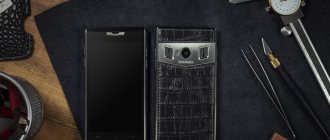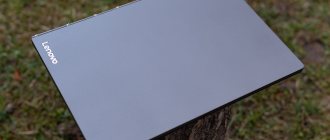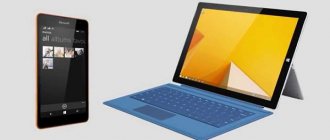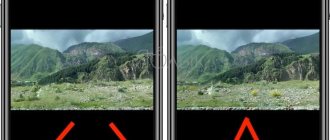Let's start with the fact that one of the smartphones - Sony Cyber-shot DSC-QX10 - was already in our test laboratory. In that previous article, we got acquainted with the device, studied how it interacts with a smartphone, and took the first pictures with it. However, since Sony smartphones not only have their own optics, but also a matrix, they can be considered full-fledged digital point-and-shoot cameras. Okay, okay, almost full-fledged: yes, they don’t have a display. Nevertheless, we will test them and treat them as full-fledged compacts - with all rigor and without any concessions. It’s not for nothing that the manufacturer included them in the Cyber-shot series of compact digital cameras.
Sony Cyber-shot DSC-QX10 - white, Sony Cyber-shot DSC-QX100 - black
When we first met the younger model - the QX10 - we did not consider the camera as a serious rival to ordinary “compacts”. Still, the resulting images could compete, for example, with photographs taken on the Samsung Galaxy S IV, but nothing more. Let’s admit, we wrote off the device as a toy-trinket. We hasten to correct ourselves: in the process of detailed study of new gadgets, our opinion gradually changed. Many people know that dozens of lenses of various types have been released for smartphone cameras - fisheye lenses, telephoto lenses, and even macro lenses. True, the quality of the image obtained with their help was often not liked by users. Smartphones are designed to change this - with their help, even an old communicator can get a good camera. Therefore, at the very least, Sony should be given a bow for attempting innovation. Camera lenses also have the zoom, so adored by many users of digital point-and-shoot cameras, and even the ability to manually adjust photo parameters, beloved by more advanced photographers. Simply put, now everything looks the same as for owners of real digital cameras.
Sony Cyber-shot DSC-QX100 - in our test laboratory for the first time
This time we had at our disposal both smartographs on the market: the younger DSC-QX10, which we studied last time, and the more serious DSC-QX100. The difference between them is colossal - the manufacturer estimated it at ten thousand rubles. The QX10 will empty the pockets of buyers by a very humane 8,490 rubles (recommended retail price), while the QX100 will ruin them by as much as 18,990 rubles. Despite the fact that the devices are similar externally (we'll talk about this a little later), internally they are completely different. And that's why.
| Sony Cyber-shot DSC-QX10 | Sony Cyber-shot DSC-QX100 | |
| Image sensor | 1/2.3" Exmor R CMOS sensor | 1 inch Exmor R CMOS sensor |
| Effective number of points, MP | 18,2 | 20,2 |
| CPU | Bionz | |
| Optics | Sony Lens G | Carl Zeiss Vario-Sonnar T* |
| Image saving format | Photo frame : JPEG Video : MP4 | |
| Focal length range, mm | 4.45-44.5mm (25-250mm 35mm equivalent) 10x zoom | 10.4-37.1mm (28-100mm 35mm equivalent) 3.6x zoom |
| Aperture opening | ƒ/3.3-5.9 | ƒ/1.8-4.9 |
| Frame size in pixels | Still image : 4864×3648 (4:3) Video : up to 1920×1080 | Still image : 5472×3648 (3:2) Video : up to 1920×1080 |
| Sensitivity, units in ISO equivalent | 100-12800, Auto (100-3200) | 160-25600 Auto (160-6400) |
| Shutter speed range, s | From 1/1600 to 4 | From 1/2000 to 4 |
| Exposure metering | Multizone | |
| Exposure compensation | ±2 EV, 1/3 EV steps | ± 3.0 EV, 1/3 EV steps |
| Built-in flash | Absent | |
| Storage device | microSD | |
| LCD display | Absent | |
| Viewfinder | Absent | |
| Interfaces | USB, Wi-Fi, NFC | |
| Nutrition | Li-ion battery NP-BN 600 mAh (2.22 Wh, 3.7 V) | |
| Dimensions (WxHxD) | 62.4×61.8×33.3 mm | 62,5×62,5×55,5 |
| Weight (camera only) | 90 g | 165 g |
Sony Cyber-shot DSC-QX10 left, Sony Cyber-shot DSC-QX100 right
The manufacturer notes that the sensor of both cameras is made using Exmor R CMOS technology (Sony's proprietary back-illuminated matrix), which achieves greater light transmittance. As a result, photos in low light conditions are more saturated. The younger model - QX10 - is similar in characteristics to an entry-level “compact”: a small, 1/2.3-inch matrix paired with low-aperture optics with a maximum relative aperture of ƒ/3.3 at the short end and ƒ/5.9 at the long end. Perhaps the most noticeable advantage of the camera is its tenfold zoom lens, covering a focal length of 25-250 mm in 35 mm equivalent. The Cyber-shot DSC-QX100 cannot boast of this - it only has a 3.6x zoom, covering a range from 28 to 100 mm (again, converted to 35 mm format). But the older model has a one-inch matrix and high-aperture optics made by Carl Zeiss with a maximum aperture of ƒ/1.8-4.9. Thus, the advantages of a large zoom are offset by the quality of the output image - we predict that the QX100 should be much better. It’s easy to figure out which of the cameras is the older one based on its dimensions - the “ten” is much smaller and almost twice as light as the “hundred”. The latter is similar in characteristics to the Sony Cyber-shot DSC-RX100 II compact camera, which we tested a few months ago.
Let us remind you if anyone has forgotten or was too lazy to study the material dedicated to the DSC-QX10 smartograph. The main feature of the new Sony cameras is that they look like interchangeable lenses. The devices turned out to be very compact and portable, if you do not take into account the lack of a display and, as a consequence, the impossibility in practice of shooting without a smartphone or tablet - “shooting” blindly is frankly inconvenient, and the percentage of defects during such shooting is off the charts.
When shooting, the camera lens can be held in your hand or attached to a smartphone. For this purpose, special sliding latches, similar to wings, are provided on the smartograph body. True, their scope is not enough for some six-inch giant like the Sony Xperia Z Ultra. However, to put it mildly, the smartphone was able to fit on the rather large Samsung Galaxy Note II, but it won’t fit on anything larger. You can also buy branded cases with supposedly a bayonet mount and turn the phone into an almost “mirrorless” camera, but for now they are only available for the Sony Xperia Z1.
Smartphone mounts on the back of the cameras
Hidden under the mount is a 600 mAh battery (2.22 Wh, 3.7 V), which is powered by the usual microUSB 2.0. The camera control keys - the power and shutter buttons, as well as the zoom lever and the already mentioned "USB" interface are scattered along the body. It is unusual to use the keys located on the body of smart phones - it is much more convenient to control devices from a phone or tablet.
Sony Cyber-shot DSC-QX10 and DSC-QX100 smartphones with standard mounts removed
⇡#Viewfinder
The shooting process is the same as in the case of a traditional digital camera - after attaching the device to the body of the smartphone, the resulting gadget cannot help but resemble a twin brother from the family of traditional “compacts”. Full likeness requires the dedicated Play Memories Mobile viewfinder app (available for Android 2.3 or higher and iOS 4.3 or higher) to take pictures. The main advantage of the program and its common feature with the line of digital cameras is the almost complete copying of the interface and control system from the body of a standard point-and-shoot camera. If you have at least briefly interacted with any modern camera before, then you should not have any difficulties when using Play Memories - all the controls and functions are so intuitive.
Viewfinder for DSC-QX10 | Viewfinder for DSC-QX100 |
It is noteworthy that smart phones, that is, the Play Memories application, provide several shooting modes. Among them there are no prepared settings for creative shooting, but there is a much more valuable semi-automatic mode - “aperture priority”. True, it is available only for the older model DSC-QX100. However, the “ten”, with its low-aperture optics and tiny matrix, does not need it - anyway, with such “hardware” it will not be possible to control the depth of field. In any case, the losses of the younger model are not great - the three automatic (“Intelligent Auto Mode”, “Super Auto Mode”, “Auto Program”) modes available for both cameras are enough for the eyes. The automation quite quickly and almost accurately estimates the exposure and white balance in the frame. Sehr gut!
The “Intelligent” and “Super Auto” modes are similar to each other, with the only difference being that the first displays the type of scene on the screen (for example, “macro” or “portrait”), while the second does its job without such prompts. The quality of images obtained when shooting in these two modes is the same. “Auto program” allows you to adjust the exposure - from -2 to +2 EV.
The Sony Cyber-shot DSC-QX100 model has a very convenient “manual” shooting mode. To change parameters, you need to click on the box of the desired parameter and thereby activate a virtual wheel with a possible adjustment range. In some ways, this interface is reminiscent of the software menu in the Canon EOS touch camera models (650D, 700D). In addition, in the settings section you can select one of many white balance “presets” or set the value manually (from 2500 to 9900 K). For some reason this option is only available in Aperture Priority mode. However, auto modes don’t need it - they themselves do an excellent job of setting the “correct” white balance.
The DSC-QX100 model has a focusing ring on the body, with which you can manually focus on the subject. True, it is not very convenient to use due to the small size of a smartphone with a camera lens. It is better to entrust this task to automation - it copes with it conscientiously.
Sony DSC-QX10 and DSC-QX100
Sony DSC-QX10 ( black , white ) — 8,900 rub. On the website: 8,490 rub. Compact cameras are not going through the best of times. The massive distribution of smartphones and other mobile devices with their own cameras makes the need to purchase a separate camera rather unobvious. On the other hand, everyone knows that smartphone cameras are, to put it mildly, inferior to specialized cameras: low light sensitivity (resulting from a microscopic matrix and weak signal processing algorithms), lack of optical zoom, image stabilization, etc. Of course, there is progress in these areas, but, in general, even the most expensive smartphone takes worse pictures than an average camera. The only problem is that a smartphone is always at hand, but a camera is usually at home, or it has been abandoned altogether in favor of a more expensive smartphone. There is another problem: there are very few smartphones focused on photography. There are separate models, but there are few of them, many are not satisfied with their performance parameters, and they are also expensive. Now, if only you could buy a decent camera for your favorite smartphone! Now this opportunity exists.
Sony DSC-QX100 — RUB 19,900. On the website: 18,990 rub.
Sony DSC-QX10 and DSC-QX100 are unique new products for your smartphone, tablet, or other mobile device running iOS or Android. Simply connect 2 devices via Wi-Fi or NFC to take photos, record videos, and instantly share photos online.
The relatively inexpensive DSC-QX10 will provide you with high-quality optics with a 10x optical zoom, a fairly large 1/2.3″ Exmor R CMOS sensor with photosensitivity up to 12800 ISO (smartphone matrices – 1/3-1/4″, ISO limit – 800-1600) and optical image stabilization in low light.
The DSC-QX100 is aimed at advanced amateur photographers. Yes, this module is more expensive than many smartphones, but inside it has a 1″ diagonal matrix, and the optics are distinguished by high aperture in the wide-angle position (F1.8 – 4.9). In this regard, the DSC-QX100 completely replicates the characteristics of the Sony DSC-RX100II. In other words, the image quality is not even at the level of compact cameras, but of cameras with interchangeable lenses. There are also shutter- or aperture-priority shooting modes, manual focusing, and an automatic dynamic range (Auto HDR) mode.
At their core, the DSC-QX10 and DSC-QX100 are independent cameras; they have everything to create a frame - optics, matrix, processor, power, memory card. You need a smartphone to frame a shot, change shooting settings, and distribute the resulting images. The two devices communicate with each other wirelessly: Wi-Fi or NFC. The lens can either be attached to a smartphone using the built-in mount, or held separately in your hands. The presence of a tripod socket allows you to use any of hundreds of different devices with a tripod screw: tripods, mini Gorillapods, monopods, suction cups, wall and window mounts, etc. The distance between the lens and the smartphone can be up to 10 meters, which opens up opportunities for non-standard angles, as well as for shooting with a hidden camera.
Of course, these devices also have disadvantages. The pleasure of working with a fairly powerful, modern smartphone will be much higher than using an outdated model that barely supports the minimum requirements (iOS 5 or Android 2.3). The standard mount is not suitable for all smartphones - models with a diagonal of 6 inches or more are already too wide, and not even all 5-inch ones can fit. Cameras still require dedicated space in your bag or pockets, and the cylindrical shape makes placement difficult. The software is still far from perfect: for example, the ISO and shutter speed control function is promised to be added only now, at the end of January; no manual exposure, no manual focus assist, no shooting in RAW, difficult to transition between shooting and viewing images. We can only hope that all this will be added over time, updates are coming out.
Positive features include a lower price, lighter weight and smaller dimensions - in comparison with a camera of the same level, high image quality and wider shooting capabilities. It's important to note that the DSC-QX10 and DSC-QX100 can be used with a huge number of devices, and if you upgrade your smartphone to a more powerful one, this camera will remain with you. Finally, these are simply unusual and amazing things that will definitely attract the attention of your friends and family. Sony DSC-QX10 and DSC-QX100 are already on sale in Bright World stores.
A short concept video from Sony with ideas on how the DSC-QX10 and DSC-QX100 can be used:
⇡#Autofocus
The autofocus system of both camera lenses works without any noticeable difficulties. Gadgets are able to “catch” focus almost accurately even in low light conditions at any focal length. The only inconvenience is the very large difference in the minimum focusing distance at different zoom positions. Moreover, both the QX10 and QX100 suffer from this. At a wide angle, both gadgets can focus at a distance of just five centimeters from the subject. This is hardly suitable for macro photography - it will turn out to be some kind of too wide-angle macro. It would seem - shoot an object close at a longer focal length. But no! At the “long end”, the minimum focusing distance increases significantly: the “older” model DSC-QX100 is capable of focusing at a distance of half a meter, and the QX10 will need more than a meter for this.
⇡#Video mode
Before we talk about testing the video shooting mode of both smartphones, we hasten to share our impressions of preparing for it. Unfortunately, far from the most pleasant. Before filming videos, you need to install flash cards in your smartphones in advance, since it is impossible to shoot videos in Full HD and simultaneously transfer them to the memory of a smartphone or tablet. Moreover, you should make sure that the device is connected correctly: during our testing, recording errors popped up, and sometimes some kind of mysticism occurred. We managed to record a test video on a microSD memory card installed in the DSC-QX10, but the “hundredth” refused to read the same “flash drive”, although there was plenty of free space on it. The other card, fortunately, turned out to be suitable for both models. So we recommend that you pay attention to this and have a couple of spare memory cards in your pocket in case similar problems arise. However, I would like to believe that this is exclusively hooliganism of our pre-production copies.
Both cameras record video in an MPEG-4 container with Full HD resolution and, for some reason, a frame rate of 29 frames per second, and not 30 or 24, as is the case in most video recording devices. The accompanying audio stream is two-channel (stereo), but we could not find two spaced-apart microphone holes on the housings, which seems somewhat strange. Probably the stereo here is software.
For a more demonstrative test of the quality of video shooting, we decided to test the cameras in low light conditions on dynamic scenes.
The QX100 handles video shooting almost perfectly. There are no claims here about the correctness of the definition of white balance. The image stabilizer does its best and does a pretty good job of properly suppressing camera shake. The QX100 lets down its autofocus a bit: there are misses here, especially when zooming on a moving subject. But when given the first opportunity to evaluate contrast-based sharpness, the QX100 does so quickly and accurately. By the way, the camera’s intelligence is well supported in this matter by the increased aperture of the optics (ƒ/1.8), so even in low-light conditions, the video shooting process will not create any particular difficulties for the operator.
We shot a similar scene with the DSC-QX10. The younger model performed significantly worse in video shooting mode than the QX100. Here the lens aperture played a fundamental role. Due to savings on the optical properties of the equipment, a greater load falls on the software part of the camera. After all, the matrix with its by no means unlimited photosensitivity capabilities will have to cope with the lack of light in the frame. The maximum ISO value is 3200 for both models, but even this is not enough for the “junior”: noise becomes noticeable in the video, and, frankly speaking, there is too much “blockage” in the shadows, so it’s hardly possible to shoot video at night on the QX10 - The videos come out too dark. Otherwise, the situation is almost similar to that of the QX100. Here, failures in autofocus accuracy are also noticeable when changing the zoom position, although the older model coped with them more quickly. The white balance assessment also turned out to be less accurate - the color temperature was recorded several hundred kelvins higher than the real one.
In general, it remains to be noted that the video recording function on these models is intended for beginners and amateurs and does not pretend to be at a more professional level. Indeed, at first glance it may seem that the picture quality is more than high (even at night), but this is achieved by all kinds of video stream compression technologies, where moiré appears in place of noise, and frame-by-frame detail decreases due to the averaging of adjacent frames. However, the DSC-QX100 will have plenty of capabilities for amateur video shooting.
Compact camera Sony Cyber-shot DSC-QX10 Black - Specifications
Compatible with iPhone and any Android smartphone. Turn your smartphone into a high-end camera: simply attach the lens to your phone. Just one touch is enough if your phone supports NFC technology. Simply place the lens on your NFC-enabled smartphone to create a wireless connection. Connect via Wi-Fi if your phone does not support NFC.
The wireless lens connects to your smartphone and offers an 18MP Exmor R CMOS sensor and 10x optical zoom. Optical SteadyShot smoothes out the effects of shaky hands for crisp photos and videos.
See things from a different angle with powerful 10x zoom. Highest level of detail even in low light. Unleash your imagination with NFC and Wi-Fi technology
Expand your boundaries and possibilities
Check out photos from the smartphone era. With simple installation, the wireless smart lens adds powerful 10x zoom and smooth image stabilization to your phone. With its help, your phone will be able to take photos you never even dreamed of.
Connection via any smartphone
Turn your smartphone into a high-performance camera. Just attach the smart lens to your phone and start shooting. The smartphone becomes a camera body: use the touch screen to take and edit photos. Upload photos and HD videos to Facebook or another site on the Internet.
Distance is not a barrier
The intelligent lens ensures great creative possibilities. Easy connection - touch the lens to your NFC-enabled smartphone to shoot from any angle. Your phone doesn't support NFC? Connect via Wi-Fi. Group Photo: Put the lens down and take a photo with your phone.
Closer than ever
Sometimes the landscape is too far away to capture on a smartphone. With G lens technology and 10x optical zoom, you can zoom in from cityscapes to endless sandy beaches. During video shooting, the active Optical SteadyShot mode compensates for shake, resulting in clear, blur-free images.
Catch the light
Low lighting? This is not a problem with the 18MP Exmor R CMOS sensor. Backlight technology lets more light into the camera—without wires blocking the path—for brighter photos. Don't sacrifice clarity: Intelligent Auto recognizes the scene and adjusts settings automatically.
Shoot quickly, shoot clearly
Festivals, trips or picnics - don't miss that once-in-a-lifetime moment. The smart lens has a built-in BIONZ image processor for clear photos and HD video, even with fast-moving subjects. The moment may last a second, but you will get a wonderful photo forever.
⇡#Examples of test images
Example photos of Sony DSC-QX10
View all images (8)
Here you can.
Example photos of Sony DSC-QX100
View all images (8)
Here you can.











